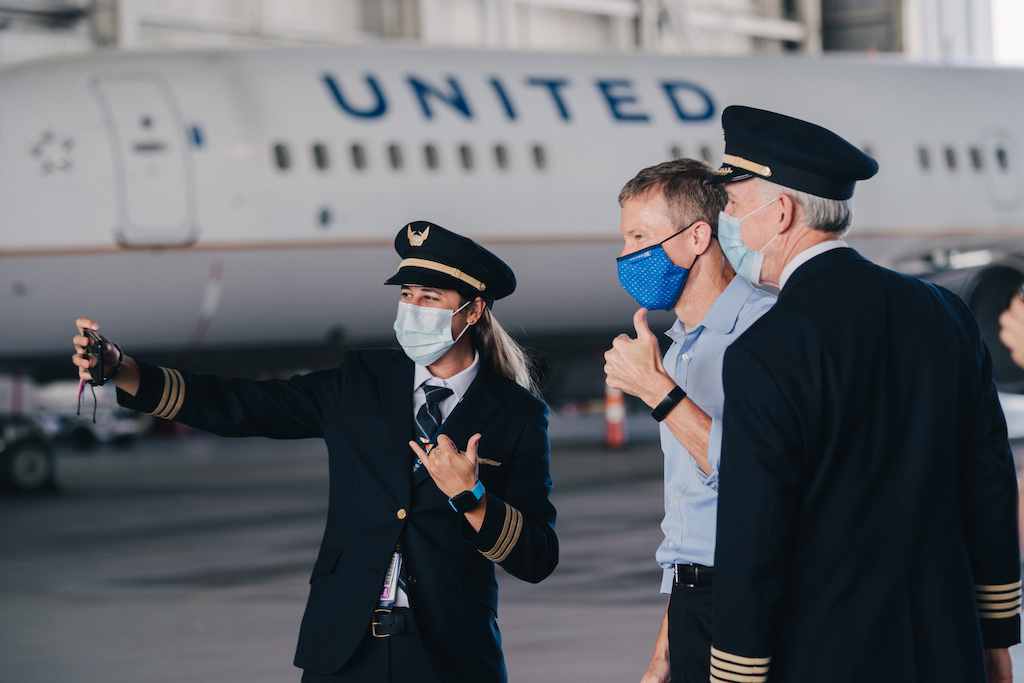United, American CEOs Say They Face a Regional Pilot Crunch

Photo Credit: United Airlines CEO Scott Kirby (center) says there is a pilot shortage in the U.S. United Airlines
Regional affiliates of American Airlines and United Airlines are taking drastic measures to attract pilots amid an increasingly dire pilot shortage in the U.S. A shortage that has prompted United to cut service to at least nine smaller cities and may limit the recovery — and growth — of the industry next year.
"Given all the accelerated [pilot] retirements that happened during Covid, and the fact that most airlines — including us — are growing a lot on the other side, the pilot shortage is now real," United CEO Scott Kirby said at the Skift Aviation Forum on Wednesday. "We don’t have enough pilots to fly all the airplanes. So the 50-seaters are at the bottom of that pile, and markets that rely on 50-seaters are the ones that are going to lose service.”
The Chicago-based carrier has already confirmed that it will exit nine smaller cities — or 11 if you count the loss of U.S. Essential Air Service contracts — almost exclusively served by 50-seat regional jets, including Bombardier CRJ200s and Embraer ERJ-145s. Cities losing United service include College Station, Texas; Evansville, Ind.; Lansing, Mich.; and Wausau, Wis.
“While there is no shortage of people who want to be pilots — we have had to put some incentives in place for regional pilots," American CEO Doug Parker said at the forum. While he did not go as far as Kirby as saying there was a pilot shortage, the fact that American is offering incentives to attract crews to its regional affiliates that operate American Eagle flights is indicative of hiring challenges.
American offers crews up to $187,500 in bonuses for taking jobs at its wholly-owned subsidiaries Envoy, Piedmont Airlines, or PSA Airlines. These incentives are divided up between sign-on bonuses when they begin work, additional money when they upgrade to captain at one of the regional airlines, and yet another bonus if they ultimately flow through to American mainline. And at United, affiliate CommutAir is offering new hires $50,000 sign-on bonuses, and GoJet Airlines up to $40,000 to new crew members. To put these numbers in perspective, the minimum pay for a new first officer at GoJet is a little over $34,500 annually.
The concerns about pilots are not new. Regional airlines have been working to address a forecast crew shortage for over a decade. The situation was made worse after the FAA implemented new training and hour requirements — the “1,500 hour” rule — in 2013 in response to a fatal Colgan Air crash four years earlier. But the pandemic has exacerbated the situation even more: After easy hiring in 2020 and 2021 as larger carriers around the world downsized, major U.S. carriers have been hoovering up regional airline pilots to keep up with a surprisingly fast recovery.
“The top five U.S. airlines lost enough pilots in 2020 to completely empty four U.S. regional airlines," Courtney Miller recently wrote in The Air Current putting the problem into perspective.
A recent report from Oliver Wyman found that, after an abundance of pilots in 2020 and 2021, North American carriers will face a shortfall of nearly 10,000 pilots by the beginning of 2022 and that number will only rise as the decade continues.
"The biggest issue we see for 2022 is that [the] supply of seats will be lower than investors are estimating because of gating factors including a lack of pilots, mechanics and customer service agents, among others," wrote Cowen & Co. Analyst Helane Becker in a report on November 12.
And any lack of pilots will, as Kirby put it, hit the smallest cities the hardest. These are the destinations served with single-class 50-seat jets that, with pilots scarce and costs rising, airlines are removing at an accelerated rate in favor of larger, newer models. United plans to retire roughly 200 of these small jets by the middle of the decade.
Some of the other staffing areas of concern cited by Becker have already hit some airlines. American and Southwest Airlines faced large operational disruptions earlier this fall when weather and other events exacerbated an already tight labor situation. Both carriers have scaled back their schedules, and are offering extra pay and bonuses to ensure smooth operations over the upcoming holiday travel season.
Not everyone believes the service cuts are entirely driven by staffing issues. Regional Airline Association (RAA) President Faye Malarkey Black said on November 8 that she was unaware "regional unable to meet capacity due to a [pilot] shortage." Instead, she suggested that United and other major airlines' desire to retire inefficient small jets may be behind some of the recent cuts.
United Senior Vice President of Domestic Planning and United Express Ankit Gupta, also speaking at the forum, is still optimistic about next summer. He does not expect staffing to limit the airline's ability to recover to 2019 capacity levels. But what Gupta did not say was that it is easy to recover top line available seat miles (ASMs) when more, larger mainline jets are added — United plans to take delivery of 48 new Boeing 737 Maxes in 2022 — even as 50-seat models are removed.
"I'm really excited about ... getting back to 2019 [flying] levels but with better product and better planes," said Gupta on United's Summer 2022 schedule. "Just getting rid of those single-cabin 50-seaters, especially in markets where they should not be flying — [I'm] really excited about that."
Updated with comment from RAA President Faye Malarkey Black.
